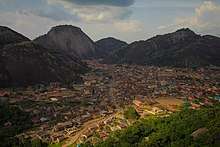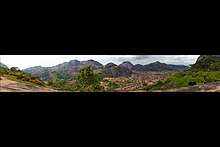Idanre Hill

The Idanre Hill, or Oke Idanre is located in Idanre town in Ondo State of southwestern Nigeria.[1]
The hill of Idanre is one of the most beautiful natural landscapes in Nigeria.[2][3] It includes such cultural sites as "Owa's Palace, Shrines, Old Court, Belfry, Agbooogun footprint, thunder water (Omi Apaara) and burial mounds and grounds".[4][5] It resides 3000 ft above sea level and houses a unique ecosystem upon which the cultural landscape has integrated. On getting to the entrance of the hill you will see a great tree at the entrance of the ancient city of Idanre called the IRAYE TREE, then you can now get prepared to take the steps to the great city beyond the hills of Idanre.
Geology

Idanre Hills is located on a Precambrian igneous batholith that is about 500 Million years old, and is cut by several large fracture that form deep valleys within the rocks.[6][5]
World Heritage status

This site was added to the UNESCO World Heritage Tentative List on October 8, 2007 in the Cultural category.[4]
Wildlife
Amietophrynus perreti, or the Perret's toad, is only known from a single locality at the Idanre Hill.[7][8] The five sites where forest elephants are found in southern Nigeria are the Omo Forests in Ogun State, the Okomu National Park in Edo State, the Cross River National Park in Cross River State, the Idanre Forests and Osse River Park in Ondo State and the Andoni Island in Rivers State. (Nigerian Conservation Foundation)
Civilization
The ancient settlement of Idanre has existed on the hill since antiquity, however Western civilization was introduced to the ancient city when a team of missionaries led by Rev. Gilbert Carter arrived in the year 1894. The missionaries built the first primary school in the year 1896 of which the clay building still stands strong till this day. In the year 1906, a law court was established which includes an ancient prison where the convicts spend their jail term.
Notes
- ↑ Oluwole Josiah (November 24, 2013). "Idanre: 660 steps to wonder hill". The Punch. Retrieved August 15, 2014.
- ↑ Adeyemi Adisa (November 29, 2010). "Idanre hill-Oke Idanre". Come to Nigeria. Retrieved August 15, 2014.
- ↑ "Idanre hills :Assemblage of Natural Architecture". People's Daily. Retrieved October 31, 2014.
- 1 2 Oke Idanre (Idanre Hill) - UNESCO World Heritage Centre
- 1 2 Anifowose, Adeleye Yekini Biodun; Kolawole, Folarin (2014-03-11). "Appraisal of the Geotourism Potentials of the Idanre Hills, Nigeria". Geoheritage. 6 (3): 193–203. doi:10.1007/s12371-014-0100-5. ISSN 1867-2477.
- ↑ Anifowose, A. Y .B.; Kolawole, F. "Emplacement Tectonics of Idanre Batholith, West Africa" (PDF). Comunicações Geológicas. 99: 13–18.
- ↑ Frost, Darrel R. (2015). "Amietophrynus perreti (Schiøtz, 1963)". Amphibian Species of the World: an Online Reference. Version 6.0. American Museum of Natural History. Retrieved 24 October 2015.
- ↑ Onadeko, Abiodun B.; Rödel, Mark-Oliver; Liedtke, H. Christoph; Barej, Michael (2014). "The rediscovery of Perret's toad, Amietophrynus perreti (Schiøtz, 1963) after more than 40 years, with comments on the species' phylogenetic placement and conservation status". Zoosystematics and Evolution. 90 (2): 113–119. doi:10.3897/zse.90.8234.
References
Oke Idanre (Idanre Hill) - UNESCO World Heritage Centre Retrieved 2009-03-03. http://www.ncfnigeria.org/careers/item/163-forest-elephant-alive-campaign